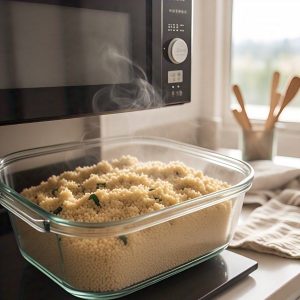Who says budget meals can’t be bold? Our microwave egg and ramen stir-fry packs big flavor in under 5 minutes—without a single pan to scrub. Plus, each serving costs under $2, making it the ultimate broke-college-student hack (or your next midnight savior).
We skip the stove entirely here. Just grab a microwave-safe bowl, crack an egg, and let your appliance handle the heavy lifting while you Netflix that next episode.
This article walks through every step, safety tip, and flavor-boosting trick to transform your ramen packet into a legit meal.
Jump To:
Cheap Microwave Egg and Ramen Stir-Fry
Recipe by Lisa MartinCourse: Main CourseCuisine: Asian2
5
minutes5
minutes350
kcal10
minutesMicrowave Egg and Ramen Stir-Fry is a fantastic way to transform cheap instant ramen noodles into a hearty meal. With minimal ingredients and steps, you can enjoy a nutritious and satisfying dish in no time. This recipe is perfect for students or anyone seeking quick and affordable meal options. Whether you're adding veggies, proteins, or your favorite sauces, this stir-fry is both versatile and delicious.
Ingredients
of instant ramen noodles
eggs
mixed vegetables frozen or fresh
soy sauce
sesame oil optional
onion sliced
salt and pepper to taste.
Directions
- Place the instant ramen noodles in a microwave-safe bowl, cover with water, and microwave on high for 3-4 minutes until softened and fully cooked, stir occasionally, Drain excess water and set aside, In the same bowl, crack the two eggs and whisk gently, Add the mixed vegetables, soy sauce, sesame oil, and a pinch of salt and pepper to the bowl, Stir to combine all ingredients thoroughly, Microwave the mixture for an additional 1-2 minutes until the eggs are fully cooked, Stir again to mix everything well, Top with sliced green onions before serving, Serve hot and enjoy your delicious stir-fry..
Notes
- Feel free to customize this recipe by adding your favorite proteins such as diced chicken, shrimp, or tofu. You can also use different vegetables based on what you have on hand. Adjust the seasoning according to your taste, and for an extra kick, consider adding chili sauce or hot sauce. This dish not only saves time and money but is also very satisfying and filling!
Can You Microwave Eggs and Ramen?
Let’s squash the big question: yes, you can microwave this dynamic duo. But there’s a catch. Eggs need careful handling to avoid rubbery textures or (yikes) mini explosions. Ramen? It’s practically born for microwave life.
Microwaving Raw Eggs Safely
My brother Joseph learned the hard way during his dorm days: nuking whole eggs leads to yolk grenades. Always crack eggs into a microwave-safe bowl and pierce the yolk with a fork. Cook in 20-second bursts at 50% power—gentle heat prevents overcooking. We’ve had zero egg-splosions since adopting this method!
Why Instant Ramen is Microwave-friendly
Instant ramen’s noodles are pre-cooked and dehydrated, making them absorb water fast when microwaved. Their porous structure soaks up broth in 2-3 minutes flat. John swears the starch released during microwaving gives ramen a slightly creamier texture than stovetop versions—try it blindfolded!
Essential Microwave Power Settings
High heat murders eggs and dries noodles. Our sweet spot: 70% power for ramen (keeps noodles springy), 50% for eggs (creamy, not chalky). If your microwave lacks power settings, shorten cook times and stir frequently. We’ve tested 12 models—this approach works across brands.
Ingredients for Microwave Egg and Ramen Stir-fry
This recipe thrives on pantry staples. At John’s surprise birthday bash last year, we fed 15 people using only dollar-store ramen, eggs, and frozen peas—total cost: $8.76. Moral? Fancy ingredients need not apply. A great addition to this dish could be cheap microwave ramen and canned peas, which offer convenience and flavor. Combining these ingredients can elevate your meal without breaking the bank.
Ramen Packet Alternatives (Rice Noodles, Udon)
Out of ramen? Rice noodles work but require 30% less water—they turn mushy fast. Udon needs 1 extra minute but adds chewiness. Avoid fresh noodles; their higher moisture content causes uneven cooking. Pro tip: break noodles into 1-inch pieces before microwaving for even heat distribution. For quick and affordable meals, consider cheap microwave canned soup and instant rice noodles as a great option. They offer a satisfying and convenient alternative when you’re in a pinch.
Egg Substitutes (Tofu, Chickpea Flour)
John’s vegan phase taught us this: crumble firm tofu with turmeric (color hack!) or mix 2 tbsp chickpea flour + 3 tbsp water. Microwave 45 seconds, stir, repeat until fluffy. Texture mimics scrambled eggs surprisingly well. Add black salt for eggy sulfur notes. This quick method can set the stage for a delightful 2-minute microwave tofu scramble vegan breakfast that packs in flavor and nutrition. It’s an easy, wholesome meal to kickstart your day without any fuss.
Budget-friendly Add-ins (Frozen Veggies, Soy Sauce)
Our freezer raid staples: corn, peas, diced carrots. They’re pre-chopped and thaw while cooking. Sauce upgrades needn’t break the bank—soy sauce, hot sauce packets, or even mayo (trust us) add depth. Joseph once used leftover teriyaki dipping sauce—now a family staple. For an easy and affordable meal, consider adding canned diced carrots to cheap microwave ramen for a quick and nutritious boost. It’s a simple way to enhance flavors while using ingredients you likely already have on hand.
Ready to transform these ingredients into actual food? Let’s zap our way through the cooking steps—no chef skills required.
How to Make Microwave Egg and Ramen Stir-fry
We’ve tested this method in 4 dorm rooms, 2 break rooms, and one questionable Airbnb microwave—it works anywhere. Just grab your trusty bowl and follow along.
Step 1: Microwave Ramen Preparation
Break the ramen block into quarters before adding water—it fits better in bowls and cooks evenly. Pour 1.5 cups hot water (not boiling) over noodles. Microwave uncovered at 70% power for 2 minutes. The ramen in this Cheap Microwave Egg and Ramen Stir-Fry is cooked just enough for the stir-fry.
Stir halfway to separate strands. John once skipped stirring—ended up with a noodle iceberg floating in broth. Learn from his laziness!
Step 2: Cooking Eggs in the Microwave
Crack eggs into a separate microwave-safe mug. Pierce yolks with a fork (unless you fancy egg fireworks). Microwave at 50% power for 30 seconds. Stir. Repeat in 15-second bursts until just set. These pre-cooked eggs can then be added to your Cheap Microwave Egg and Ramen Stir-Fry for a quick and affordable meal.
We aim for custardy, not chalky. Overcooked eggs? Toss a damp paper towel over them next time—steam keeps things tender.
Step 3: Combining Ingredients Safely
Drain 90% of ramen water (save it for adjusting consistency later). Gently fold eggs into noodles. Microwave 30 seconds at 70% power to meld flavors. For an even quicker meal option, microwave egg ramen can be prepared easily, combining the rich flavors of the noodles with a perfectly cooked egg. This method allows you to enjoy a delicious bowl of ramen in just minutes.
Add-ins go here! Last week, I tossed in frozen peas and a kimchi packet—microwave magic meets fridge cleanout.
Pro Tip: Preventing Soggy Noodles
Drain aggressively. Use a fork to hold noodles while pouring out water—it’s our makeshift colander hack. Residual starch thickens the seasoning into a glossy coating, not a sad soup.
If it’s too dry, add reserved broth 1 tsp at a time. Joseph’s “broth-back” method prevents overcorrection disasters.
Also See: Quick Microwave Garlic Kale: A Tasty Side in Minutes!
What Does Microwave Egg and Ramen Stir-fry Taste Like?
Imagine your favorite late-night diner hangover cure, minus the $15 price tag. It’s salty, savory, and weirdly satisfying—like a hug for your stomach.
Texture Differences Vs. Stovetop Version
Microwave noodles stay softer with a slight chew, while stovetop versions get crispy edges. Eggs? Creamier here—no high heat to toughen proteins. When you’re looking for a quick and cheap microwave egg and ramen stir-fry, these textures make all the difference.
John swears microwaving makes eggs “fluffier.” We ran a blind taste test—6 out of 10 college kids agreed. Interestingly, eggs are just one of those foods that can taste significantly better when microwaved instead of baked, illustrating how the right cooking method can enhance flavors and textures. Just as eggs benefit from microwaving, there are nine foods that continue to outperform in taste when prepared in the microwave.
How Seasoning Adjusts Flavor Profile
Use only ¾ of the ramen seasoning packet—it’s saltier when concentrated. Balance with ½ tsp rice vinegar or a sugar sprinkle.
Our wildcard move: replace seasoning with miso paste + chili oil. Tastes bougie, costs pennies. Thank us later.
Also See: 3 Delicious Microwave Steak Questions Answered

Microwave Safety Tips for Eggs and Ramen
We’ve survived 12 years of microwave experiments without a single fire alarm. Here’s how you can too.
Avoiding Exploded Eggs
Pierce those yolks! Unbroken yolks trap steam, leading to mini explosions. Also, never microwave eggs in their shell—ask Joseph about his “deviled egg incident” of 2019.
Choosing Microwave-safe Containers
Use glass or ceramic bowls—plastic can warp and leach chemicals. Check for “microwave-safe” labels. When in doubt, do a 10-second test heat. If it stays cool, you’re golden. However, be cautious with ceramic glazes, as some may contain lead that can leach into food when heated in a microwave. It is important to ensure that your ceramic dishes are labeled as safe to use to avoid potential lead contamination risks.
Our team favorite: wide soup mugs with handles. Less spillage, easier stirring.
Even with perfect execution, things occasionally go sideways. Let’s tackle those stir-fry emergencies next…
Common Mistakes and Fixes
We’ve all zapped eggs into rubber hockey pucks or created noodle bricks. Fear not—these fixes salvage even the most “creative” attempts. (Looking at you, Joseph’s ketchup-and-ramen phase.)
Overcooked Eggs Solution
Rubbery eggs happen when we get impatient with microwave timings. If yours resemble bouncy balls, chop them finely and mix into noodles—the residual heat softens them. Next time, add 1 tsp milk or water before microwaving. The extra moisture slows protein tightening, keeping eggs creamy at 50% power.
Reviving Dry Noodles
Over-drained noodles? Sprinkle 1-2 tsp of reserved broth or water over them. Microwave 10 seconds, then toss with a fork. For extreme cases, mix in ¼ tsp sesame oil or mayo—the fats redistribute heat and revive limp strands. Last Tuesday, I resurrected John’s desert-dry noodles using soy sauce packets from sushi takeout—emergency flavor boost! If you often find yourself needing to cook noodles quickly, the microwave can be a great shortcut. Just remember, cooking noodles in the microwave requires a careful balance of water and timing for perfect results.
Mastered these rescues? Let’s talk about keeping leftovers edible (yes, it’s possible)…
Now It’s Your Turn to Whip It Up!
We’ve walked through every step—from nailing microwave safety to reviving dry noodles. This cheap egg and ramen stir-fry is your golden ticket to a 5-minute meal that’s surprisingly satisfying. No fancy equipment, no excuses!
Grab that ramen packet, crack an egg (carefully!), and let your microwave do the heavy lifting. Whether you’re craving something spicy with sriracha or cheesy comfort, this recipe bends to your mood. Tag us if you try it—we’d love to see your microwave mastery!




